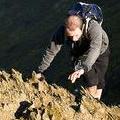It's pretty simple. There are nine, sort of, rules that I discovered after 35 years of rock climbing. Most of them are pretty basic.
Number one: Don't let go -- very sure success method. But really, truly -- often you think about letting go way before your body does. So hang in there, and you come up with some pretty peculiar solutions.
Number two: Hesitation is bad. This is a friction climb, up in Tuolumne Meadows, in the Yosemite high country. Friction climbing doesn't have any sort of hard positive edges. You're climbing on little dimples and nubbins in the rock. The most friction you have is when you first put your hand or your foot on the rock. And then from that point on, you're basically falling. So momentum is good. Don't stop. Rule number three: Have a plan. This is a climb called the Naked Edge, in El Dorado Canyon, outside of Boulder. This climber is on the last pitch of it. He's actually right about where I fell. There is about 1,000 feet of air below him. And all the hard pitches are actually below him. Often what happens is you're planning so hard for like, "How do I get through the hardest part? How do I get through the hardest part?" And then what happens? You get to the last pitch. It's easy. And you're completely flamed out. Don't do it. You have to plan ahead to get to the top.
But you also can't forget that each individual move you have to be able to complete. This is a climb called the Dike Route, on Peyrat Dome, up in the Yosemite high country. The interesting thing about this climb is it's not that hard. But if you're the leader on it, at the hardest move, you're looking at about 100 foot fall, onto some low angle slabs. So you've got to focus. You don't want to stop in the middle like Coleridge's Kubla Kahn. You've got to keep going. Rule number five: Know how to rest. It's amazing. The best climbers are the ones that in the most extreme situations can get their bodies into some position where they can rest, regroup, calm themselves, focus, and keep going. This is a climb in the Needles, again in California.
Fear really sucks because what it means is you're not focusing on what you're doing. You're focusing on the consequences of failing at what you're doing because any given move should require all your concentration and thought processes to execute it effectively. One of the things in climbing is, most people sort of take it straight on. And they follow the most obvious solution. This is the Devils Tower in Wyoming, which is a columnar basalt formation that most of you probably know from "Close Encouters." With this, typically crack climbers would put their hands in and their toes in, and just start climbing. The cracks are too small to get your toes into so the only way to climb is using your fingertips in the cracks, and using opposing pressure and forcing yourself up.
Rule number eight: Strength doesn't always equal success. In the 35 years I've been a climbing guide and taught on indoor walls, and stuff like that, the most important thing I've learned was, guys will always try to do pull-ups. Beginning guys, it's like, they thrash, they thrash, they get 15 feet up. And they can do about 15 pull-ups right? And then they just flame out. Women are much more in balance because they don't have that idea that they're going to be able to do 100 pull-ups. They think about how to get the weight over their feet because it's sort of natural. They carry you all day long. So balance is really critical, and keeping your weight on your feet, which is your strongest muscle.
And of course there is rule number nine. I came up with rule number nine after I actually didn't plan for a fall, and went about 40 feet and cracked a rib. Once you get to that point where you know it's going to happen, you need to start thinking about how you're going to let go because that is the critical piece of not getting hurt -- how you're going to fall on to the rope, or if you're climbing without a rope, fall to a place where you can actually control the fall. So don't hang on till the bitter end. Thank you very much. (Applause)

